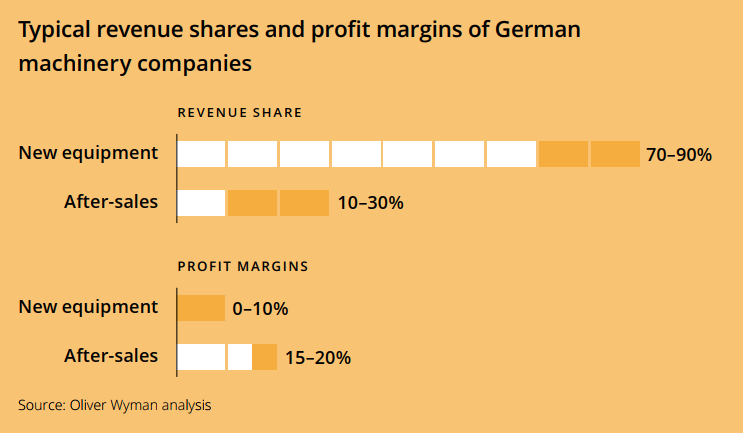A digital customer portal is a platform for strengthening the increasingly digitalized customer relationship. It offers your clients access to their order history, self-services, delivery status and more. A digital customer portal will make purchasing spare parts, accessories, consumables, but also configuring complex machines easier, while lowering overhead costs and improving the efficiency of your (and your customers’) processes! This article will explain the main benefits of a digital customer portal in B2B:
- A digital customer portal can increase customer satisfaction and retention
- A digital customer portal enables more revenue with higher gross margins
- A digital customer portal takes pressure off your sales staff
- A digital customer portal will prepare you for constant innovation
- A digital customer portal can lighten the load of the IT team
In a digital customer portal, users can oversee and manage their installed base, purchase spare parts or consumables, book services or individualized training. A personalized experience puts them at ease, and in an attractive, clear, and accessible manner they benefit from an optimized buyer journey.
55% of e-commerce leaders invest in a digital customer portal
A survey (conducted by Copperberg) of 125 e-commerce executives in manufacturing showed that 55% of the respondents plan to invest in a digital customer portal. A digital customer portal allows customers to “… take care of their company and account data themselves, without calling their sales agents for every adjustment." It's the next step of digital commerce, a level-up of your basic B2B online shop. So, let's take a few moments to explore the benefits of a digital customer portal in B2B:
1. A digital customer portal can increase customer satisfaction and retention
The majority of B2B buyers are (or will be soon) digital natives. They expect the same service experience and usability they are accustomed to as B2C consumers. Examples: they shop on Amazon, receive personalized recommendations on Netflix and Spotify and manage their insurance policies via service portals. B2B personalization, however, is working differently.
So, providing the right information to the right customer at precisely the right time, will make the jobs of B2B buyers easier. It will boost customer satisfaction and retention. Services play an important role in driving customer satisfaction, but the buying experience is yet more important.
Digital product information can be detailed specifications, technical documentation, technical drawings, high-resolution images and multimedia content. But that’s not all. Modern sales departments support their clients with self-service digital configurators, making sure to meet all their need without mistakes. This way, they request only what can be delivered. Your sales rep will be enabled to tell the customer when the product will be ready since data on availability can easily be included in the digital configuration.
If the digital customer portal accesses information on the installed base of the customer, your sales rep can configure push notifications for new products, additional consumables or relevant services. And in after-sales, perfectly fitting cross- and up-sell possibilities can be found in an instant – or even replacements with spare parts for certain products, to remain flexible.
2. A digital customer portal enables more revenue with higher gross margins
A digital customer portal will almost automatically lead you to collect many customer data, e.g. their buying history. This helps you to create personalized and perfectly timed recommendations. As after-sales initiative, you can tailor cross-selling and up-selling offers (like consumables, services and add-on insurance) to introduce existing customers to new products and services. These offers are particularly effective if they offer specific added value for your customers and have high gross margins.

3. A digital customer portal takes pressure off your sales staff
When your sales guys as well as your customers have access to real-time updates on the status of the latest quotes, orders, or deliveries, account managers can solve more pressing matters than answering those recurring status questions. Fixing pressing matters is what strengthens your customer relationship! Also: When customers handle their personal account data themselves, errors are reduced.
Personal meetings can become more valuable, when improvements of products, novelties and process optimizations can be discussed. Therefore, dedicated field sales apps (mobile versions of the digital customer portal based on a PWA) can be used, which shorten the decision-making process.
In short, sales managers benefit from digital commerce in their everyday work because:
- They get access to sales statistics where it is possible to see if sales are on target and detect customers which offer higher margins.
- They can organize their routes to become more efficient.
- They may use transparent, efficient and structured communication channels with their customers.
4. A digital customer portal will prepare you for constant innovation
Do you know what your customers want in 3 or 5 years? New services, touchpoints, processes? B2B organizations are constantly evolving and transforming how they engage and interact with other businesses, buyers, companies, and partners. No single monolithic solution is capable of handling our current world of endless technological advances and constant change.
That’s why many B2B companies decided to implement a B2B commerce platform with a composable commerce architecture that focuses flexibility and modularity. But what exactly is composable commerce? Composable commerce is a development approach of selecting best-of-breed commerce components and ‘composing’ them into a custom application built for specific business needs. Now, this possesses several advantages (enabling constant customer centricity is just one of them!) but also disadvantages. Forrester says that by 2023, many companies will fail with their e-commerce projects because they got overwhelmed with their projects trying to control and add too many components and microservices to their e-commerce while using this composable commerce approach.
The perfect balance between one big solution – the traditional e-commerce platform approach – and multiple microservices – the composable commerce approach – does the trick here. By implementing a B2B digital customer portal that combines the stability and ease of use of traditional e-commerce platforms with the vital customization and flexibility options of composable commerce, you will hit the ‘goldilocks zone’ of B2B e-commerce. To stay innovative, simply add another or a different feature, touchpoint or tool as a “packaged business capability” via standard API to your digital customer portal.
5. A digital customer portal can lighten the load of the IT team
A digital customer portal is a presentation shell or user interface on top of all kinds of enterprise-wide services. It streamlines orders from your commerce system or from other (offline) sources, IoT data from machines and installed base systems, financial data out of ERP and billing systems, tracking data out of supply chain systems etc.
To support your company’s growth ambitions, the technology should be cloud-based to make easy scaling possible - in terms of traffic, products, regions and much more.
Such a cloud-based SaaS solution is usually maintained and operated by the software vendor and frees your IT team in terms of development, administration and operation.
Is a cloud-based digital customer portal too expensive? Just comparing the price for hardware, software licenses and storage capacity is not enough. It is also important to weigh up the solution’s availability, security and performance against cost. And strategic factors count, too – such as the question whether an organization wants to focus on its core competencies and outsource non-core activities.
When it comes to the total cost of a system, one core factor is the variability of application requirements. When you think of how the traffic on a system can fluctuate, pay-per-use models of external cloud commerce providers enable obvious cost savings compared to an internal IT department that will always have to maintain the ability to run the application at maximum capacity – regardless of whether this capacity is always fully used.
Do you want to know more about the value of a digital customer portal? Download our whitepaper and find all the answers!







